
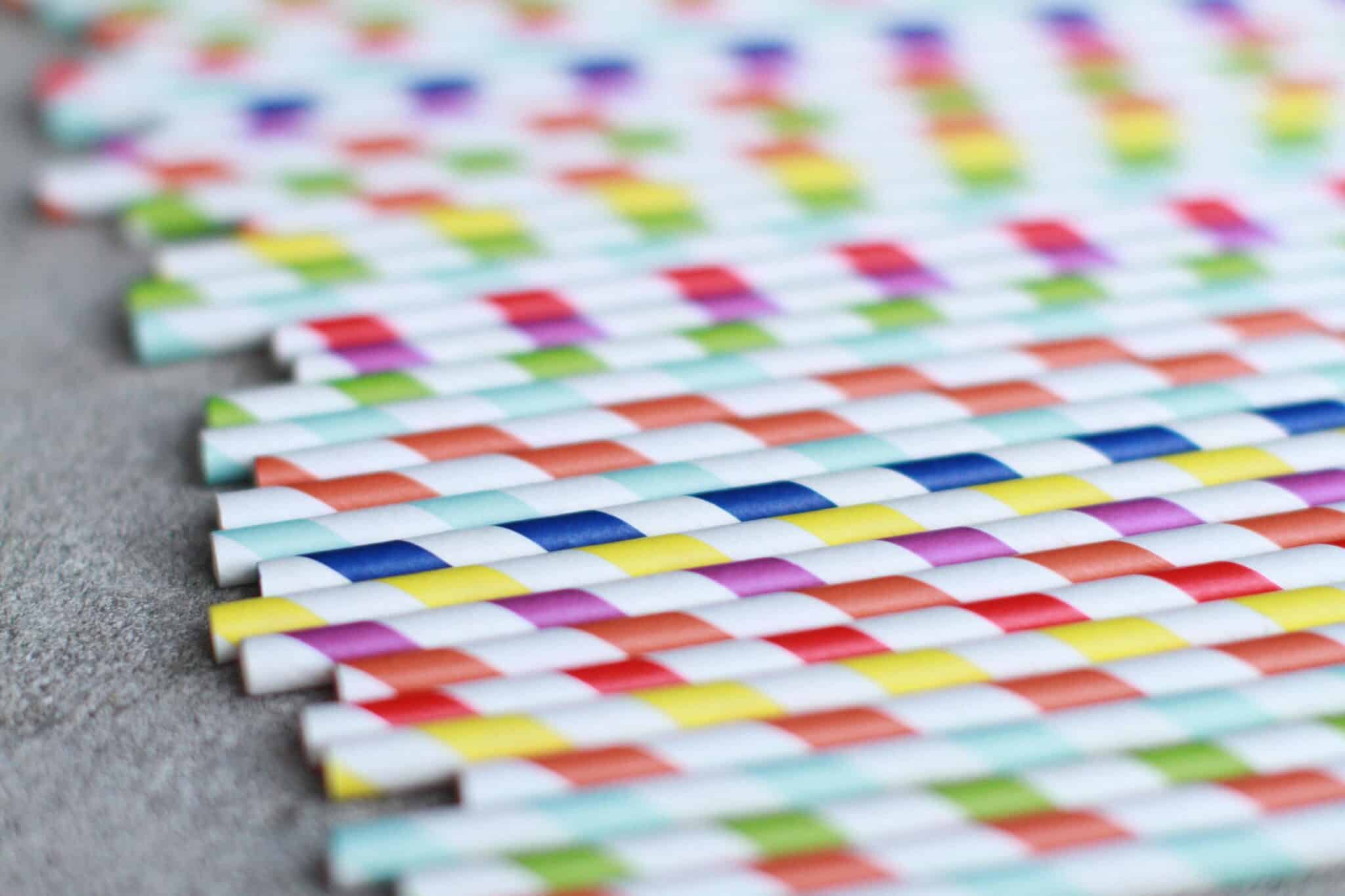
Meghan Rodgers / Unsplash
Keeping a reusable straw in your purse, pocket, on your key ring, or in the glove compartment of your car makes it easy to skip single-use plastic when you’re on the go. In fact, purchasing reusable straws, made from materials like bamboo, glass, silicone, and stainless steel, is one of the simplest ways to reduce your waste.
Americans use between 170 to 390 million straws a day, according to market research firms cited in a New York Times article. Whether your city is banning plastic straws or you just want to be more eco-friendly while sipping your iced coffee, here are the 10 best reusable straws to invest in this year.
10 Best Reusable Straws:
1. Best Overall: Klean Kanteen Stainless Steel Straw Set
2. Most Sustainable: Koffie Straw
3. Most Popular: FinalStraw Collapsible Reusable Metal Straw
4. Best Silicone: GoSili Reusable Silicone Straw
5. Best Metal: Friendly Straw Six Pack
6. Best Glass: Hummingbird Glass Straws
7. Best Bamboo: ECO/EGO Handcrafted Organic Bamboo Drinking Straws
8. Best Collapsible: Flyby Portable Reusable Drinking Straws
9. Best Wide: Teivio Reusable Glass Straws
10. Best For Kids: Softy Straws Silicone Straws
Each product featured here has been independently selected by the writer. If you make a purchase using the links included, we may earn commission.
1. Best Overall Reusable Straw: Klean Kanteen Stainless Steel Straw Set
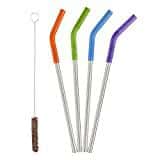
Klean Kanteen’s mission is rooted in making high-quality, long-lasting products that are good for the planet. And its Stainless Steel Straw Set seamlessly follows suit. These hybrid silicone and metal straws are perfect for everyday use, as they’re safe to use with both hot and cold beverages and hold up through many cycles in the dishwasher.
Customer Rating: 4.7 out of 5 stars
Why Buy: Zero-waste; Supports 1% for the Planet; B Corp; Climate Neutral Certified; BPA-free; Vegan; Dishwasher safe
2. Most Sustainable Straw: Koffie Straw
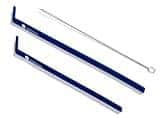
They’re durable enough to hold up for years, but at the end of their life, Koffie Straws can be burned into biodegradable ash, which keeps them from clogging landfills. The packaging that each straw comes in is also compostable, so if you’re looking for zero-waste reusable straws, these could be your best bet.
Customer Rating: 4.7 out of 5 stars
Why Buy: Zero-waste; Compostable packaging; Dishwasher safe; Vegan; BPA-free; Biodegradable
3. Most Popular: FinalStraw Collapsible Reusable Metal Straw
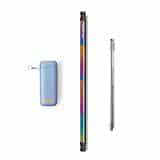
You may recognize FinalStraw Collapsible Reusable Metal Straws from the company’s viral advertisements or .89 million Kickstarter campaign. And as it turns out, the folks at Final are as good at making straws as they are at marketing them. The stainless-steel-and-silicone FinalStraw is designed to fold down into a convenient case that can be attached to your key ring or stashed in a pocket or purse.
Customer Rating: 4.6 out of 5 stars
Why Buy: Supports 1% for the Planet; Made with post-consumer recycled materials; Latex and BPA-free; Portable; Carrying case and cleaning brush included
4. Best Silicone Straw: GoSili Reusable Silicone Straw
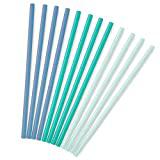
The GoSili Reusable Silicone Straw comes in a couple of lengths to fit standard cups or larger eco-friendly water bottles. It is made with soft, European-grade silicone and can be folded into its lightweight aluminum case for easy carrying. When it eventually comes time to recycle your straw, if your local recycling facility doesn’t accept silicone, you can send it back to GoSili and the company will recycle it for you.
Customer Rating: 4.7 out of 5 stars
Why Buy: BPA-free; Portable; Carrying case included; Dishwasher safe; Minimal packaging
5. Best Metal Straw: Friendly Straw Six Pack
Looking for the best no-frills metal straw? Try the Friendly Straw Six Pack. This set of three straight and three bent straws lets you choose the ideal angle for sipping your favorite beverages. All are dishwasher safe, come with a carrying pouch, and include a brush to make cleaning a breeze.
Customer Rating: 4.4 out of 5 stars
Why Buy: Dishwasher safe; Rust-proof stainless steel; Carrying pouch and cleaning brush included; Paper packaging
6. Best Glass Straw: Hummingbird Glass Straws
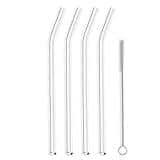
If metal isn’t quite your thing, you may like glass. Glass reusable straws are lightweight and have a smooth mouthfeel, plus it’s easier to see if they’re dirty. We like Hummingbird Glass Straws, which are handmade in Colorado using durable borosilicate glass, which is more shatter-resistant than regular glass.
Customer Rating: 4.8 out of 5 stars
Why Buy: Zero-waste; Nontoxic; Plastic-free; Dishwasher safe; Handmade in the U.S.; Paper packaging; Cleaning brush included
7. Best Bamboo Straw: ECO/EGO Handcrafted Organic Bamboo Drinking Straws

ECO/EGO Handcrafted Organic Bamboo Drinking Straws are a great biodegradable, long-lasting option for reusable straws. Each straw is made from 100% natural bamboo, and this set of 12 comes with its own carrying pouch and a cleaning brush. What’s more, the company donates 10% of its profits to helping save wildlife like sea turtles, koalas, dolphins, and otters.
Customer Rating: 4.7 out of 5 stars
Why Buy: Zero-waste; Biodegradable; Supports wildlife conservation; Carrying pouch and cleaning brush included; Plastic-free packaging; 100% natural bamboo
8. Best Collapsible Straw: Flyby Portable Reusable Drinking Straw

Many reusable straws on our list come with a carrying pouch of some kind, but that doesn’t mean they are all compact or lightweight enough to comfortably fit in your pocket. Enter the Flyby Portable Reusable Drinking Straw. This telescopic straw can be adjusted to fit different glasses, comes in an ultralight aluminum case with a carabiner attachment, includes a telescopic cleaning brush for washing on the go, and has a silicone tip for a smoother sip.
Customer Rating: 4.4 out of 5 stars
Why Buy: Dishwasher safe; Adjustable length; Plastic-free packaging; Carrying case and cleaning brush included; Nontoxic
9. Best Wide Straw: Teivio Reusable Straws
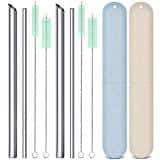
While a standard-sized straw will work in most situations, some drinks may require something a little wider. For smoothies, milkshakes, and boba tea, we recommend Teivio Reusable Glass Straws. This set comes with two standard straws, two extra-wide straws, a pair of cleaning brushes, and two handy cases made from biodegradable wheat straw.
Customer Rating: 4.7 out of 5 stars
Why Buy: Case made from biodegradable wheat straw; Wide; Nontoxic; Cleaning brush included
10. Best Reusable Straw For Kids: Softy Straws Silicone Straws
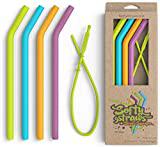
Reusable straws set a great example of stewardship for your little ones, but it’s important to make sure they’re bite-safe. Softy Straws Silicone Straws are flexible yet durable and come in kid-friendly colors. They’re also BPA-free, lead-free, and have passed rigorous safety testing to ensure they’re safe for the whole family.
Customer Rating: 4.7 out of 5 stars
Why Buy: Dishwasher safe; BPA-free; Lead-free; Cleaning squeegee included
Buyer’s Guide: Which Reusable Straw Is Right For You?
We’ve listed 10 of the best reusable straws to choose from, but which one is best for you? When buying a reusable straw, you’ll want to take into account factors such as whether you want to take your straw on the go — and, thus, whether it folds down or has a carrying case of some sort — and whether it’s important that it’s dishwasher safe.
You’ll also want to choose which material you prefer:
- Silicone: If you’re a habitual straw biter or have young children, Silicone will likely be your best bet. These soft reusable straws are ultra flexible, nontoxic, and are available in many different colors. They don’t hold a shape as well as some alternative materials, but that’s precisely what many users like about them.
- Stainless steel: Metal straws made with food-grade stainless steel are often a cheap option, but they hold up over time. While some people complain about a metallic taste and heating up when drinking hot beverages, others prefer these straws for their durability. Additionally, some stainless-steel straws come with silicone tips that can be used if you don’t like how hard the metal is on your teeth.
- Glass: Glass reusable straws have a smooth mouthfeel, are lightweight, and can come in a variety of aesthetically pleasing hues. You can rest assured they won’t be made with BPA or other harmful toxins, but one common concern with glass straws is how breakable they are. To combat this, look for straws made from a material like borosilicate glass that’s more shatter-resistant.
- Bamboo: Reusable straws made from bamboo are completely biodegradable, making them especially sustainable. Like glass, they’re lightweight and have a smooth mouthfeel, however, they can have a slight woody taste. And if you want a bent straw, you’ll need to choose another material — these only come stick-straight.
Melissa Smith is an avid writer, scuba diver, backpacker, and all-around outdoor enthusiast. She graduated from the University of Florida with degrees in journalism and sustainable studies. Before joining EcoWatch, Melissa worked as the managing editor of Scuba Diving magazine and the communications manager of The Ocean Agency, a non-profit that’s featured in the Emmy award-winning documentary Chasing Coral.

 233k
233k  41k
41k  Subscribe
Subscribe 